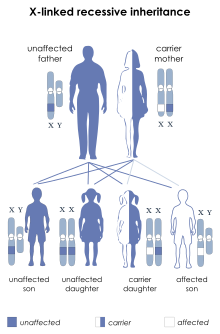| Ocular albinism type 1 | |
|---|---|
| Other names | Nettleship–Falls syndrome |
 | |
| Ocular albinism type 1 is inherited in an X-linked recessive manner | |
| Specialty | Endocrinology |
Ocular albinism type 1 (OA1) is the most common type of ocular albinism, with a prevalence rate of 1:50,000.[1][2] It is an inheritable classical Mendelian type X-linked recessive disorder wherein the retinal pigment epithelium lacks pigment while hair and skin appear normal.[3][4] Since it is usually an X-linked disorder, it occurs mostly in males, while females are carriers unless they are homozygous.[5] About 60 missense and nonsense mutations, insertions, and deletions have been identified in Oa1. Mutations in OA1 have been linked to defective glycosylation and thus improper intracellular transportation.[6]
The eponyms of the name "Nettleship–Falls syndrome" are the ophthalmologists Edward Nettleship and Harold Francis Falls.
- ^ W.S., Oetting (February 2002). "New insights into ocular albinism type 1(OA1): Mutations and polymrphisms of the Oa1 gene". Human Mutation. 19 (2): 85–92. doi:10.1002/humu.10034. PMID 11793467. S2CID 42778083.
- ^ Incerti, Barbara (2000). "Oa1 knock-out: New insights on the pathogenesis of ocular albinism type 1". Human Molecular Genetics. 9 (19): 2781–2788. doi:10.1093/hmg/9.19.2781. PMID 11092754.
- ^ Burns, W.N., Schiaffino, V.M. and Lewis, R.A. (1998). Repeated transmission of X-linked ocular albinism type 1 by a carrier oocyte donor. Fertility and Sterility 70(6):1169.
- ^ Carden, S.M., Boissy, R.E., Schoettker, P.J. and Good, W.V. (1998). Albinism: Modern molecular diagnosis. British Journal of Ophthalmology 82:189.
- ^ Shen, Bin (August 2001). "Ocular albinism 1: More than meets the eye". Pigment Cell Research. 14 (4): 243–248. doi:10.1034/j.1600-0749.2001.140403.x. PMID 11549106.
- ^ Schiaffino, M.V., d'Addio, M., Alloni, A., Baschirotto, C., Valetti, C., Cortese, K., Puri, C., Bassi, M.T., Colla, C., De Luca, M., Tacchetti, C. and Ballabio, A. (1999). Ocular albinism: Evidence for a defect in an intracellular signal transduction system. Nature Genetics 23:108.